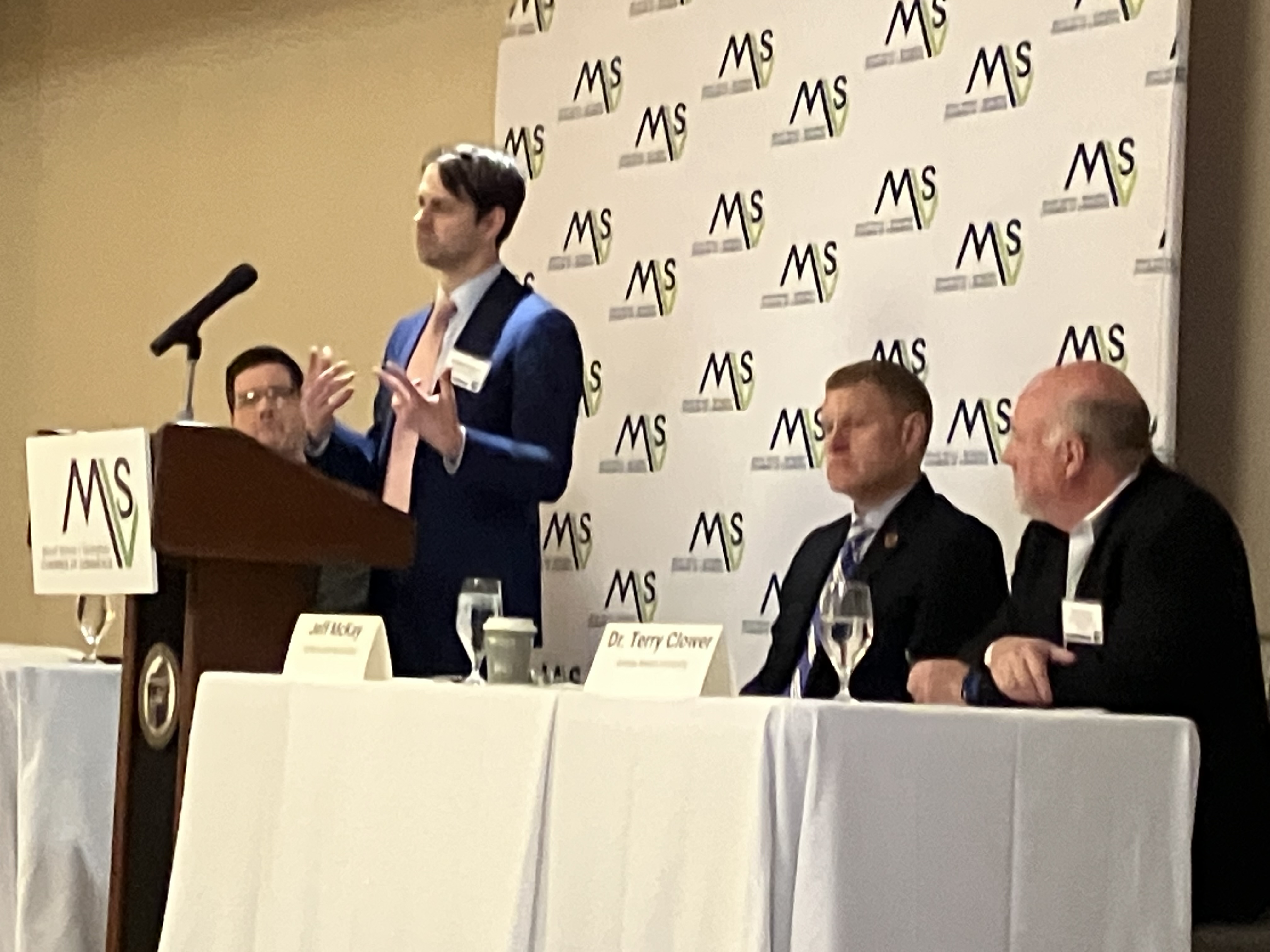Thursday, April 17, 2025
On April 3, one day after U.S. President Donald J. Trump announced sweeping tariffs on imports from over 60 countries, several Northern Virginia officials gave a pep talk to 75 business leaders who gathered for a breakfast of scrambled eggs, bacon and hope.
On April 4, the day of the event, stock market indexes tumbled. “Tariffs Torpedo Markets around the World,” screamed an Associated Press headline.
The speakers did not utter the U.S. president’s name, but the changes and proposals, coming largely from the
 Stephen Juneau, Bank of America Securities, discussed recent developments with interest rates and the national anticipated forecast for inflation.
Stephen Juneau, Bank of America Securities, discussed recent developments with interest rates and the national anticipated forecast for inflation.
Bank of America economist Stephen Juneau warned that these are “difficult, uncertain times.”
Dr. Terry Clower, Director of George Mason University ‘s Center for Regional Analysis, predicted, “We will have a period of real pain.”
Spotlighting the County’s Strengths
One of the event’s sponsors, Kathy Taylor with the Walsh Collucci law firm, touted, “Our community is strong, dynamic and resilient.”
Fairfax County Board of Supervisors Chairman Jeff McKay sang the praises of Fairfax County, saying that there is “no better place to be than here in tough times,” that the county has a “strong backbone and a strong economy. I am optimistic about our ability to get through this.”
Listing some plusses, McKay commended the public school system and noted that Fairfax County is home to ten Fortune 500 companies and “a great place for small employers.” Recovering from the Covid pandemic crisis, more people are working and more businesses than ever are operating, he said.
McKay refuted reports that Fairfax County’s population is declining, asserting, “That is completely false.” In 2023-2024 Fairfax County grew by 14,000 people, the highest of all Northern Virginia jurisdictions, he said. “We are in growth mode.”
He singled out plans to redevelop U.S. 1 in Mount Vernon. The stretch between Fort Belvoir and Huntington “is ripe for redevelopment and investment,” and will be an economic driver, like Metro’s Silver line, he said, adding, “Never before has Fairfax County had a $1 billion infrastructure investment in U.S. 1.”
Alex Iam, Executive Vice President of the Fairfax County Economic Development Authority (EDA), also spotlighted local assets, citing “world class talent” and strong aerospace, information technology and satellite communications industries. “We have a great aggregation of intelligence resources in the region,” he said, showing a slide reporting 500+ cybersecurity companies in Fairfax County, and noting that Virginia is the “top state for digital infrastructure.”
Iam reported that some of the largest tenants in the county like Northrop Grumman retained their leased office space over the past two years and some, like Bechtel, expanded.
But Iam tempered his upbeat report by acknowledging that the federal government has a big presence with 80,000 federal employees in Fairfax County. “Federal contracting is huge,” he observed, totaling $41 billion in federal procurement in 2024.
There are six major federal headquarters in Fairfax County, including the Transportation Security Association and the U.S. Geological Survey. Current actions to shrink the federal government through workforce cuts, contract cancellations and real estate space reductions is a “very serious situation,” he soberly asserted.
EDA seeks to help displaced federal employees and contractors, with steps like job fairs and encouraging retraining.
Adjusting to Economic Shifts
“The federal government will still be big, but it will be smaller,” Clower predicted. He estimated that 125,000 federal workers “will be lost” and said that federal spending is typically “worth another 1.4 jobs, so in the next few years, we could see 250,000 jobs gone. It’s sobering,” he said.
Clower said that Northern Virginia’s economy is “shifting, … changing into a data driven economy.”
“We must rethink the way we are doing things,” he challenged. If the federal government abandons office space, public-private partnerships could step in. “We have a basis to compete for new industries,” he said.
Clower expressed optimism that the region could retain former federal employees, capitalizing on “the sheer brain power in this region. Get them to stay while we restructure,” he urged.
He stressed that the region needs “to be more open to development,” to incentivize businesses to come to the area, by speeding up permitting, for example.
On population trends, he attributed the county’s growth to net international migration, contending that domestic migration is “negative” because people ages 30 to 40 cannot afford a house here. “The housing stock is still a real challenge,” he said.
Evan Kaufman, the Southeast Fairfax Development Corporation’s Executive Director, said, “We must be nimble and turn this negative into a positive.”
Tinch closed by urging attendees to be positive and innovative “in a changing environment. … Be ready for uncertainty,” she advised. “We are a resilient county.”
The Mount Vernon Springfield Chamber of Commerce and the Southeast Fairfax Development Corporation hosted the event at the Belle Haven Country Club. Sponsors were Walsh, Colucci, Lubeley and Walsh; IMEG; and Bean, Kinney and Korman.